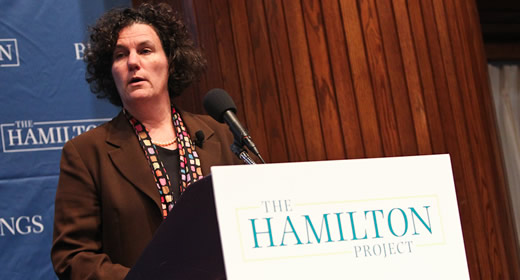
One lesson that Susan Dynarski learned from her long-standing campaign to simplify financial aid is that stubbornness—and a willingness to say the same thing over and over again—is critical to moving public policy.
“As academics we are not trained to do this; you write a paper and then you move on,” says Dynarski, professor of public policy, education, and economics. But, in order to impact policy, you need to keep hammering at it.
That is just what Dynarski has been doing. Her target: the Free Application for Federal Student Aid, known as FAFSA. Any student who wants a federal loan or Pell grant to help finance a college education has to file this form.
But FAFSA’s length and complexity make it a formidable barrier.
The problem is greater for those the form has the most potential to help: students who come from low-income families, those who are first generation college-goers and whose parents have difficulty helping with the form, or those who face language or cultural barriers.
Starting with her doctoral dissertation in economics at MIT in 1999, Dynarski has been among a cadre of researchers working to show that the relative complexity of programs matters. Dynarski applied those notions to education finance, thinking that the complexity of financial aid programs could have an important impact on their effectiveness.
She had been exposed to this first-hand. Being the first in her family to attend college made Dynarski particularly attuned to the barriers many students like her face. Difficulties in her family with filling out the FAFSA form had a negative impact on her financial aid.
In 2006, Dynarski wrote a paper specifically on the FAFSA with Judith Scott-Clayton, who was her student at the time and is now tenured faculty at Teachers College, Columbia University. In the paper, they provided a quantitative view of the unnecessary complexity of the FAFSA, documenting the sheer number of questions and showing that the vast majority of them did very little to select the students most likely to benefit from financial aid. In fact, they found that if you asked just four questions—including one on income and another on family structure—the answers could explain 90 percent of the variation in financial aid eligibility.
The paper left an impression that went beyond academia. “Literally the thing that had the greatest impact was showing that there were more questions in the FAFSA than in the 1040 Tax form,” says Dynarski. “That idea stuck.” As a result, they were invited by the Brookings Institution’s Hamilton Project to write a policy proposal to remedy the issue.
The proposal went viral in policy communities and generated many news articles. The notion of simplifying or eliminating the FAFSA was picked up by political campaigns on both sides of the aisle during the 2008 presidential election.
In part, the bipartisan appeal of the proposal was a result of a conscious effort to try to narrow the range of disagreement. The papers focused on how to distribute the existing level of aid in the most effective way possible. “Some call that marginalism and don’t like it because it is insufficiently ambitious,” Dynarski says. “But small things matter.”
In fact, researchers Eric P. Bettinger, Bridget Terry Long, Philip Oreopoulos, and Lisa Sanbonmatsu have since demonstrated just how much they matter. When they offered a randomly selected group of low-income students help with filling out the FAFSA, they found that making the process easier resulted in an 8 percentage-point increase in low-income students going to college and completing two years of college education.
After President Obama came into office, some legislative progress on FAFSA simplification was made. Several questions were knocked out of the form but, as can happen in the legislative process, a few were added as well. As the legislative progress stalled, most of the action moved to the regulatory side. The Obama administration made the online version of the form easier, introducing a tool that allowed linking applications to Internal Revenue Service data so that tax information could be automatically filled in. In addition, they moved the application date earlier so that prospective students can now have more information about funding before they decide where to apply for college.
Dynarski and Scott-Clayton, together with Mark Wiederspan at Arizona State University, have periodically re-run their original analysis to see how those changes have impacted the application.
And they continue to press the issue. Dynarski has been writing on the economics of education for the New York Times where her articles have become a powerful platform to promote simplification of financial aid, even receiving the unexpected support from the Times editorial board. Both Dynarski and Scott-Clayton recently testified before the U.S. SenateHealth, Education, Labor and Pensions Committee, as it considers simplifying financial aid along the lines they had suggested in their initial policy paper as part of the Reauthorizing Higher Education Act.
“It has been a little bit frustrating that the federal policy hasn’t changed more than it has,” Scott-Clayton says. “At the same time, it is very encouraging to see how much the conversation around the country and on the ground has changed. Institutions, new scholarship programs, and advocacy organizations are all doing their part to help ameliorate the barriers that students are dealing with. Even if the federal policy isn’t radically different yet, I do feel like there is more support for students to navigate the process than there was 10 or 15 years ago.”
--Story by Miriam Wasserman
Below is a formatted version of this article from State & Hill, the magazine of the Ford School. View the entire Spring 2018 State & Hill.